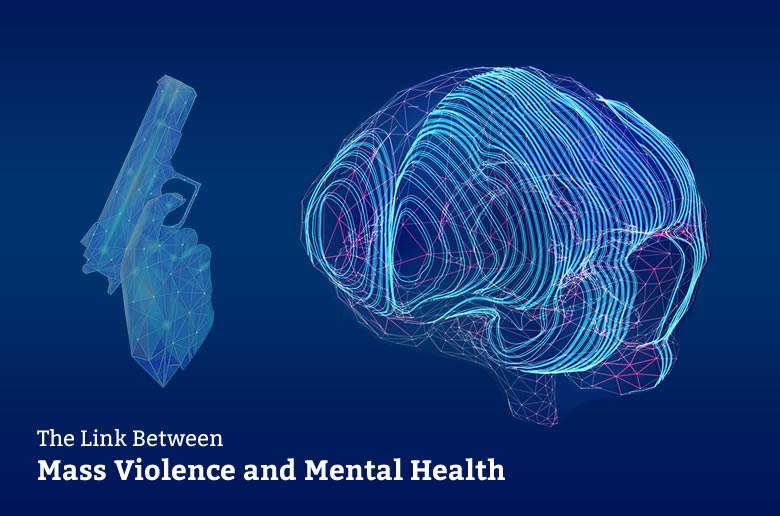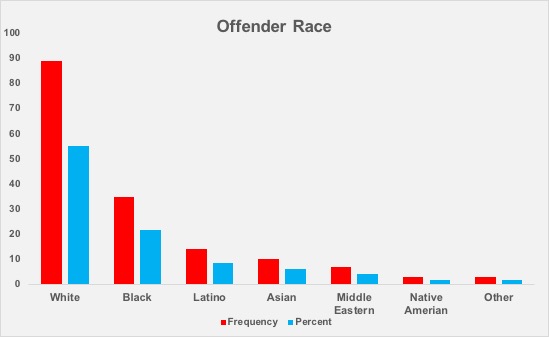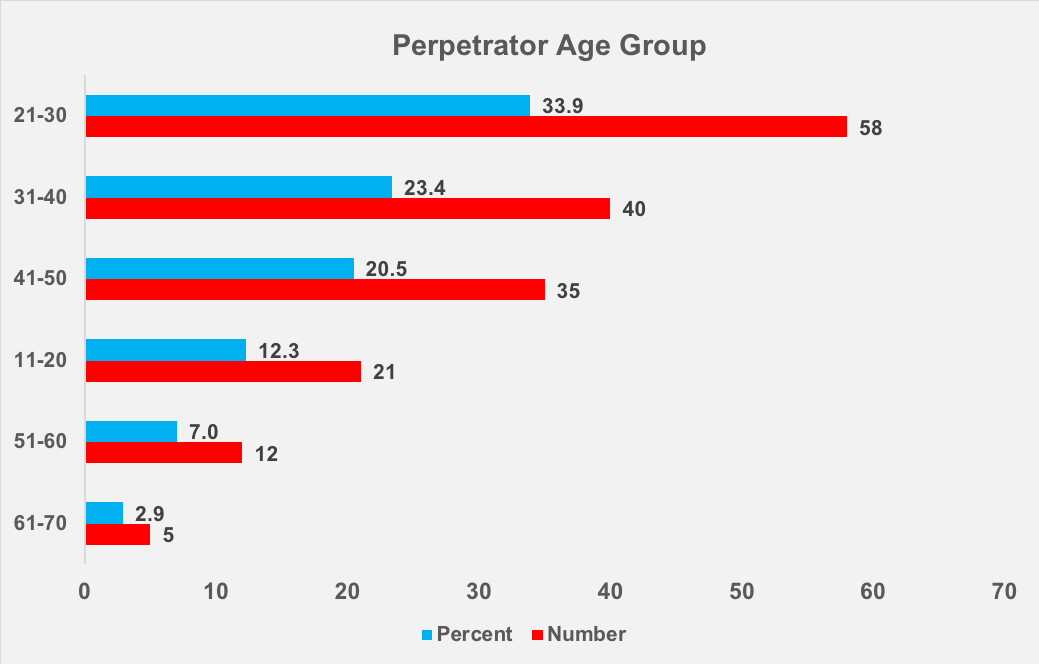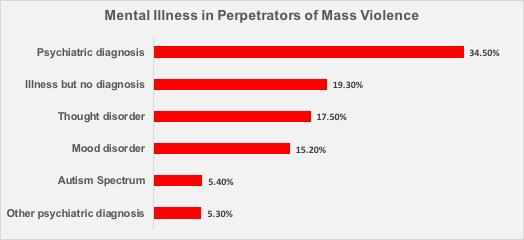Mass violence events seem to be occurring more often around the world with alarming frequency and takes place in a variety of ways. Terrorist bombings, hijackings, and certainly, active shooter incidents. Thankfully, these events are rare in the U.S.; still, a perpetrator of mass violence can leave a trail of destruction in his path that impacts many lives for years to come.
The term mass killing refers to three or more killings in a single incident while a mass shooting or mass violence event is defined as an incident in which four or more people are killed by a perpetrator in one event and in one or more locations in close proximity.
Between 1966 and 2018, there have been 1,239 killed and 2,020 injured in mass shooter incidents in the U.S. alone.
These events are unpredictable and so when they do occur, victims often suffer from overwhelming anxiety and other psychological symptoms that can manifest days, weeks, or even months after the event has occurred and can last for indefinite periods of time.
In fact, the National Center for PTSD has estimated that some 28% of people who have witnessed mass violence develop post-traumatic stress disorder (PTSD) and about a third develop acute stress disorder.
Using data compiled by The Violence Project, we looked at some of the characteristics of perpetrators of mass violence and how crisis or some form of mental illness may have contributed to their acts.
Perpetrators of Mass Violence
While perpetrators of mass violence can certainly vary from individual to individual, there are some characteristics they tend to share. Shooters tend to be predominantly Caucasian, feel victimized, bullied, or harassed, and relate to others they perceive to be similarly mistreated. They also are often indifferent to life and subsequently die by suicide.
Nearly all, for example, were males (98.2%) who were single, recently divorced, or separated (66.6%). Ages ranged from as young as 11 years old to age 70, with an average of 34 years.
Relationship Status of Mass Violence Perpetrators
| Relationship Status | Frequency | Percentage |
|---|---|---|
| Single | 82 | 50.62 |
| Divorced/Separated/Widowed | 26 | 16.05 |
| Boyfriend/Girlfriend | 24 | 14.81 |
| Married | 30 | 18.52 |
| Total | 162 | 100 |
A full 84% showed some sign of being in crisis before their violent act, including
- Suicidality at any point before shooting – 30.4%
- Intended to die in shooting – 39.3%
- Employment change or trouble – 44.4%
- Interpersonal conflict – 22.6%
- Relationship issues – 11.6%
- Recent traumatic breakup – 77.3%
Others were known to have a history of violence (61.9%), experiencing extreme hopelessness, or harboring grievances related to work, finances, or interpersonal relationships. The Violence Project data also revealed the following about the perpetrators:
Trauma and Crisis in Perpetrators’ Lives
- Bullied 17.80%
- Grew up single parent 22.80%
- Childhood trauma 52%
- Abused by father 22.50%
- Abused by mother 2.90%
- Abused by family member(s) 2.00%
- Abused by another party 3.90%
- Both parents 2.90%
- Adult trauma 19.20%
- Prior hospitalization 19.00%
- Prior counseling 24.70%
- Psychiatric meds 21.20%
- Other major trauma 17.60%
Nearly 64% had criminal records or prior contact with police as shown by the chart below:
In their report, the FBI found that a third of mass shooters and nearly two-thirds of active shooters had been convicted of a crime as an adult (35%) or had a history of acting aggressively toward others in the workplace (62%). They also found that nearly 20% had histories of domestic violence and 11% exhibited stalking behaviors.
Mental Health and Mass Violence
While mental health is not necessarily synonymous with a diagnosis of mental illness, it can certainly explain how someone who is in poor health psychologically can act in ways that they otherwise would not. Many perpetrators of mass violence were known to display signs of serious mental illness before their crimes against others.
A 2012 study by Follman, Aronsen, and Pan focused on indiscriminate rampages in public places and found that the majority of the killers displayed signs of mental illness long before setting out to kill.
Even those without serious diagnosable disorders have been found (in unfortunate retrospect) to have “gone over the edge) due to some kind of life stressor for which the person could or would not seek help. A June 2018 report by the Department of Justice confirmed this; it revealed that active shooters had an average of 3.6 major stressors in their lives at the time of the shooting. These ranged from mental health issues such as depression and anxiety to financial problems or the death of a relative.
The assumption is often that people who commit these crimes must have experienced some event that “suddenly” sent them “over the edge” and out to massacre others. This is true and not true. While the question after a mass violence event is often, “What made this perpetrator snap?” the signs were there already for those who were paying attention. Researchers often refer to this as the pathway to violence. Behaviors include:
- An unshakable sense of grievance
- Thoughts about harming others
- Planning and preparation for attack
- Obsession with weapons
- Fixation on violence
- History of aggression
- Signal of intention (called leakage)
Suicidal Ideation
Suicide is a serious issue when it comes to risks related to firearms and often gets overlooked in reports related to mass violence. People are more likely to intentionally kill themselves with a gun than to be killed by a gun in a mass shooting or other type of homicide (Wintemute, 2015). Many perpetrators of mass violence do, however, carry out their acts fully intending to commit suicide or to commit “suicide by cop” – in other words, forcing law enforcement to shoot them instead of doing so themselves – once they have carried out their plans.
| On Scene Outcome | Frequency | Percent |
|---|---|---|
| Killed self/resigned to die | 65 | 38.01 |
| Killed on scene | 33 | 19.30 |
| Apprehended | 71 | 41.52 |
| Apprehended, then suicide before trial | 2 | 1.17 |
| Total | 171 | 100% |
Data from The Violence Project confirms these findings. Additionally, many “leaked” their intentions on social media, had a notable obsession with firearms, showed intense interest in past mass violence, relationship with another shooting, and left evidence the attack had been planned out ahead of time. Some (nearly 24%) had even left Legacy Tokens behind at the scene.
| Motivation and Social Contagion | Percentage |
|---|---|
| Planning | 25.60% |
| Fame Seeking | 6.50% |
| Leakage Prior to Shooting | 48.50% |
| Interest in Past Mass Violence | 22.20% |
| Relationship to Other Shootings | 12.30% |
| Legacy Token | 23.70% |
Improved background checking before issuing guns to those who are suffering from mental illness is an important piece in preventing violence of this kind.
The Mother Jones study found that:
- Out of the 143 guns possessed by shooters between 1982-2012, 75% had guns they obtained legally- most because background checks were insufficient or missed vital information
- Most (80%) of the perpetrators who purchased guns displayed acute paranoia, delusions, and depression
- In almost every instance, the killings were carried out by lone shooters in public places
- Most perpetrators died by suicide or suicide by cop
Mass shootings represent a very small fraction of overall gun violence. Still, mass shooters who go on rampages do so with every intention of slaughtering innocent people. For that reason, it is vital that those who go to purchase firearms are properly screened. Of course, firearms are often obtained illegally in straw purchases, are stolen, or are those not belonging to the gunman at all (school shooters, for example, tend to get their weapons from friends or family members).
| Legal Purchase of Firearms | Frequency | Percent |
|---|---|---|
| Purchase was illegal | 31 | 27.19 |
| FFL (background check missed something) | 73 | 64.04 |
| Unregulated private sale | 4 | 3.51 |
| Legal but specific source unknown | 4 | 3.51 |
| Legal purchase but modification to firearm illegal | 2 | 1.75 |
The importance in studying these trends is to hopefully recognize the signs in those who would potentially commit such crimes and prevent mass violence before it occurs.
A paper by the National Council for Behavioral Health examined existing data and expertise on mass violence and provided an analysis about its causes and impacts. The following recommendations were made:
Threat Assessment and Management
Threat assessment is a strategy to prevent violence toward others. It is no longer considered a single assessment but rather an ongoing process with interventions. A threat assessment team that includes representatives from law enforcement, behavioral health, and others who can assess where a person is on the pathway to violence as well as the individual’s risk factors is merited.
Revise Ill-considered Policy Decisions
School shootings grab national headlines for obvious reasons but have resulted in some ill-considered policy decisions. One example is the use of zero-tolerance policies in schools. The result is that students are suspended for minor misbehaviors, sometimes unnecessarily. In addition, excessive security measures and unannounced school-shooter drills can be psychologically traumatizing. Though some safety drills are warranted, those that evoke unnecessary fear and create trauma do more harm than good.
Communitywide Involvement
A Communitywide Problem Demands a Communitywide Solution. No one organization can solve the problem alone. Vigilance is required by all.
- Primary Care Providers: Providers have an opportunity to uncover, diagnose, refer, and treat underlying mental disorders (e.g., conduct disorder, depression, psychosis).
- Behavioral Health Providers: Although there is a modest link between mental illness and violence, the timely availability of quality mental health treatment is vital.
- Law Enforcement: In many parts of the country, local, state, and federal law enforcement officials are being trained to respond to calls that involve people in crisis, including but not limited to those with mental illnesses. The goal is for officers to divert these individuals from the legal system by diffusing the situation, working collaboratively with their mental health colleagues, and linking the individuals to services.
- Media: In the age of 24-hour cable news and the internet, it has become increasingly difficult to control uninformed narrative about a mass violence event. The media can play its part by not sensationalizing violence and reporting responsibly and sensitively.
Resources
Best, T. (2019). Trauma, Anxiety and PTSD: How mass shootings affect mental health. https://abcnews.go.com/Health/trauma-anxiety-ptsd-mass-shootings-affect-mental-health/story?id=63491970
Follman, M. (2015). Inside the race to stop the next mass shooter. https://www.motherjones.com/politics/2015/10/mass-shootings-threat-assessment-shooter-fbi-columbine/
Follman, M., Aronsen, G., & Pan, D. (2019). A guide to mass shootings in America. https://www.motherjones.com/politics/2012/07/mass-shootings-map/
Marcus, E. (2019). New study on mass shootings explores the traits that define perpetrators. https://www.mic.com/p/new-study-on-mass-shootings-explores-the-traits-that-define-perpetrators-19366339
National Counceil for Behavioral Health. (2019). Mass violence in America. https://www.thenationalcouncil.org/wp-content/uploads/2019/08/Mass-Violence-in-America_8-6-19.pdf
Novotney, A. (2018). What happens to the survivors? Monitor on Psychology, 49(8), 36. https://www.apa.org/monitor/2018/09/survivors
Peterson, J., Densley, J. (2019). Op-ed: We have studied every mass shooting since 1966. Here’s what we’ve learned about the shooters. https://www.latimes.com/opinion/story/2019-08-04/el-paso-dayton-gilroy-mass-shooters-data
The Violence Project. (2019). Mass shooter database. https://www.theviolenceproject.org/mass-shooter-database/
Timmons, H. (2018). The FBI’s warning signs to identify a mass shooter before he strikes. https://qz.com/1456558/the-fbis-warning-signs-of-a-mass-shooter/
U.S. Department of Veterans Affairs. (2019). What to expect in the wake of mass violence. https://www.ptsd.va.gov/understand/types/mass_violence_help.asp
Victim Connect Resource Center. (2019). Mass violence. https://victimconnect.org/learn/types-of-crime/mass-violence/








No Comment